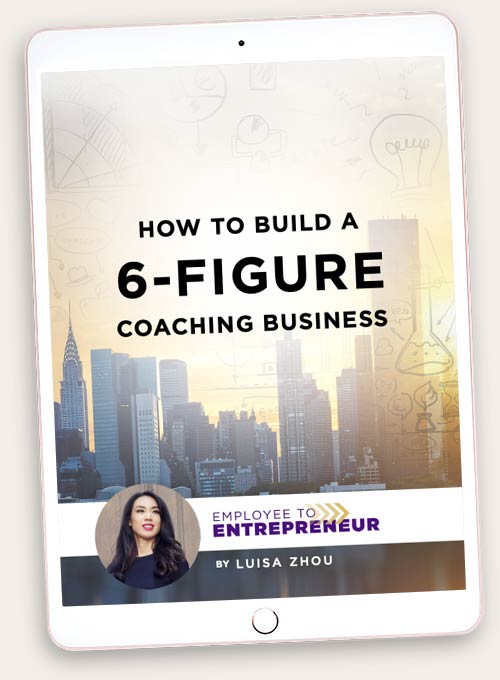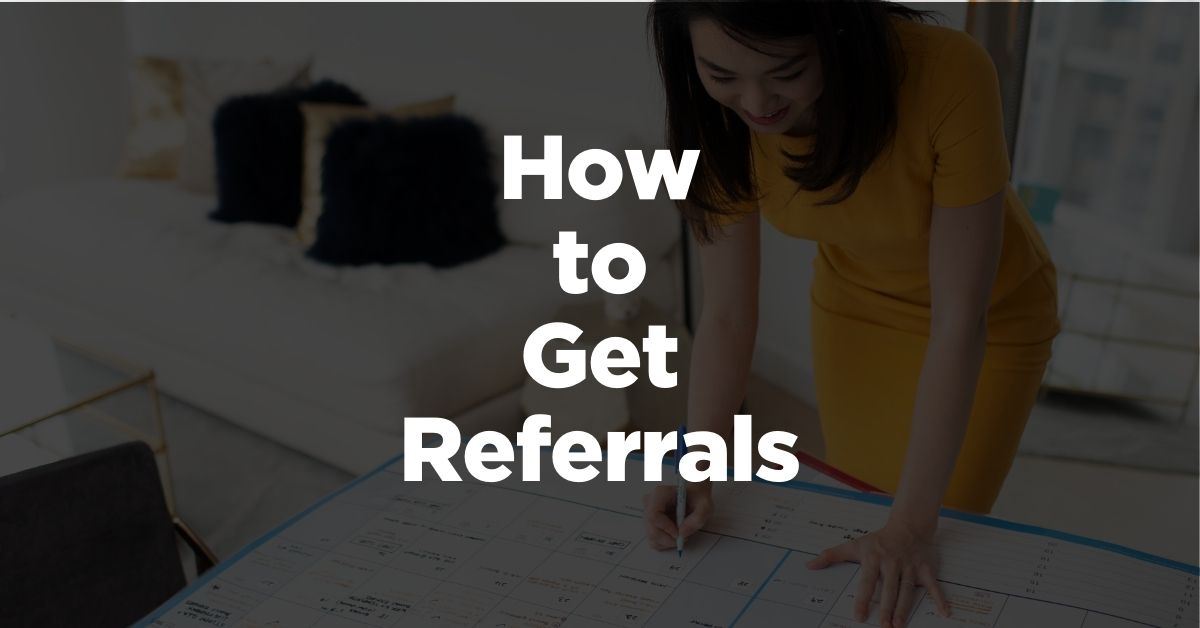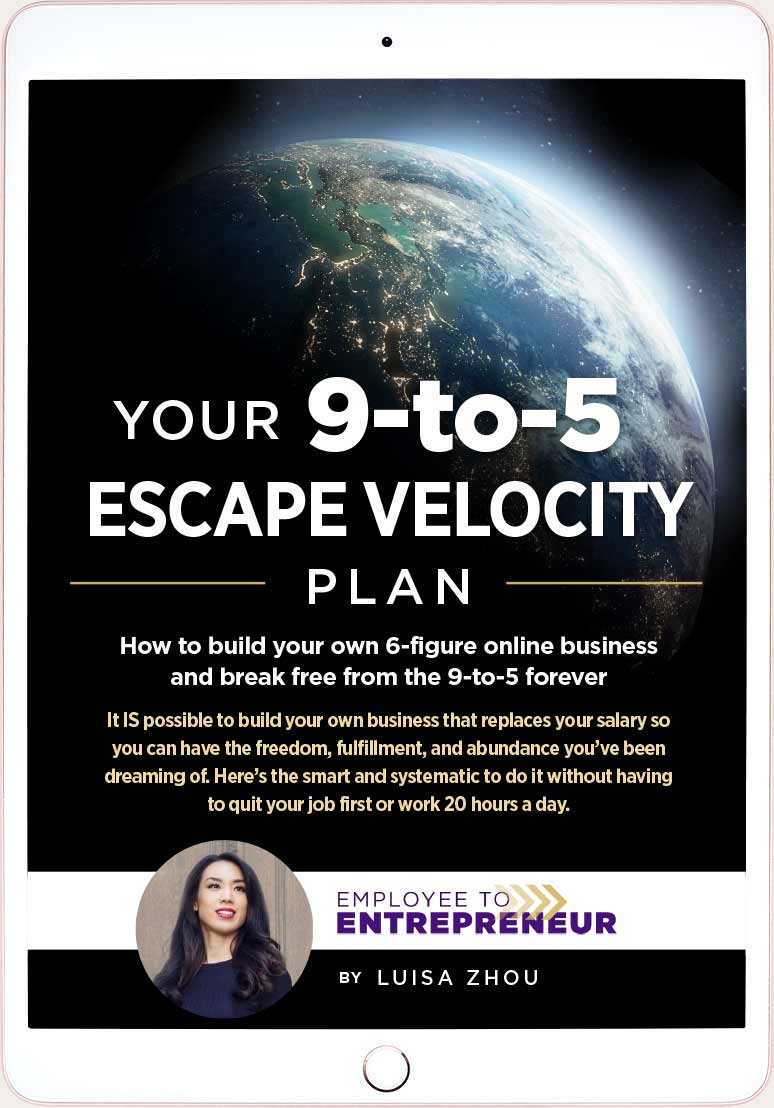This is the ultimate guide on how to ask for referrals – and get far more clients (without a lot of effort).
You’ll learn:
- What a referral is – and isn’t
- How to ask for referrals from customers (the RIGHT way)
- The different methods for asking for referrals (with templates)
Want to learn more? Read on!
What is a referral email?
A referral, also known as word-of-mouth marketing, is when a person recommends a service or product to someone in their network. For example, if you’re looking for a new hairdresser, you might ask your friends for a referral.
Referrals aren’t to be confused with testimonials.
Testimonials are (usually positive) reviews from people who have already worked with you. They also tend to be public.
Get the Ultimate Guide
for building a
6-Figure Coaching Business so you can achieve more freedom!
Referrals can come from people you’ve worked with or not. And they involve the referrer having a relationship with the referee. After all, 92% of customers trust referrals from friends and family over anything else.
Now, a referral email is an email a business owner, like you, would send to customers and people in your network to ask for referrals.
A good referral email should include a:
- Headline that grabs the reader’s attention
- Reminder of what you do and the result you’ve created together
- Line requesting referrals
- Incentive or offer
- Call to action
Next, let’s talk about how to construct referral emails that help you get you new potential clients.
How do you ask for referrals from customers?
To ask for the best referrals, you need to ask in the right way.
How? Here are the steps to take:
- Figure out who to ask
- Ask at the right time
- Tailor your message
- Offer a commission
- Use a referral code
- Stay top of mind
- Give referrals
- Follow up on your messages
- Offer free work sessions or samples
Let’s look closer at each of these steps.
1. Ask your network and clients
You probably already know someone who needs what you’re offering.
Or if you don’t, you probably know someone who knows someone who needs what you’re offering.
And people in your network are more likely to be open to hiring you or sending people your way as referrals.
But here’s a common mistake:
You don’t want to spam your contact list and say “Hey, I’m starting a new business. You should hire me.”
That can come off as salesy and pushy. Instead, you want to create a shortlist of clients, colleagues, friends, and family members who are likely to help you or need your help.
These people are more likely to be your biggest cheerleaders and refer you to whoever they can.
But you might be wondering, who are the best people to ask for referrals?
Your previous clients.
After all, they can talk about their experience working with you and the results you helped them achieve.
But when should you ask for referrals? Let’s talk about it.
2. Ask at the right time
Most people ask clients for referrals immediately after the contract ends.
Or worse, a few days, weeks, or even months after.
That’s a mistake, and here’s why:
Even if you deliver an amazing service and the client is overwhelmed with the results, they’ll never be as excited as they are when they are actively working with you.
Think about it.
If you hire a personal trainer and they help you lift your body weight, are you more likely to tell your friends when you hit the goal or a few weeks after?
Asking for referrals at the right time helps your client feel more confident about recommending you to people in their network.
So the best time to ask for a referral is when your client achieves that win before the project ends.
Note that the results don’t need to be major milestones – you can ask for referrals after smaller results, too.
Next, let’s look at how to ask for referrals in the right way.
3. Tailor your message
Exactly how do you ask your clients for referrals?
The most important thing is:
Tailor your message.
No one likes receiving a generic mass email that could be for anyone. This is not cold calling. A well-worded referral can strengthen your relationship. A bad, generic referral can make someone feel used.
So don’t skip this step.
Now, how exactly do you personalize each referral email?
Simple. You can include things that relate to the work you did with them.
For example:
- If it’s a friend or family member, refer to a conversation you had recently.
Example: “You know that XYZ business I wanted to start? I finally started it and am offering XYZ services. If you know anyone who might need me…” - If it’s an existing client, mention a recent win they had.
Example: “I’m so happy that you achieved XYZ result. I want to help other people like you achieve the same. So if you know anyone who might need my services…” - If it’s a past client, remind them of a win they had working with you.
Example: “Together, we achieved XYZ. It’s my mission to help others achieve results like yours, so I wondered if you know anyone who might be interested…” - If it’s someone you don’t know very well, mention how you met.
Example: “It was great to meet you at the XYZ conference last Friday. You mentioned that you may know someone who would be interested in working with me…”
Tailoring your message makes the person feel valued and appreciated as you ask them for a referral. And so they’ll be more likely to help you.
4. Offer a commission
One of the best ways to get a referral is to offer an incentive.
And commissions are great incentives for referrals.
A common commission on services is 10% on the income you receive from the referred client. If you offer retainers, the commission applies to every month you work together with a referred client.
And if you sell products, then the commission will vary. For instance, software products often have a 10%-30% monthly commission, physical products tend to have a 10% commission, and online products typically have a 50%-75% commission.
Here’s the thing:
By offering a commission, you make people you reach out to feel valued and incentivize them to keep referring people to you in the future.
After all, you want something from them – it’s only fair that you offer something back as a thank you.
Next, let’s look at how to incentivize referrals with referral codes.
5. Use a referral code
Make referring you as easy as possible.
Specifically, referral codes can make referring you incredibly easy – and you might tap into a broader audience of people willing to spread the word about your business.
Referral codes are short code snippets that let you track a referral back to a referrer. The referrer is incentivized to refer you more because they build their referral income each time, they refer someone to you.
To create your referral code, you can use a tool like Talon to create the codes for you.
But how do you use your referral codes?
Include them on your website, in your emails, or send them to people directly.
Tip: Public referral codes work better for product businesses. Personalized referral codes work best for service or course businesses.
Get the Ultimate Guide
for building a
6-Figure Coaching Business so you can achieve more freedom!
6. Stay top of mind
It’s simple:
People are more likely to refer you if you’re the first person that comes to mind when someone asks them for a referral.
So you need to make yourself the go-to person for the service you provide.
For example, if you’re a nutrition coach, and a friend of a friend is trying to change their diet, you want to be the first person they think of.
How do you do that?
Easy: Create free content. By sharing content, you build a relationship with potential clients and referrers by sharing your expertise online. They see you in their feeds every day – and stay top of mind.
Choose a platform where your ideal clients are most likely to hang out, be it LinkedIn, X Instagram, or TikTok. But here’s the tip that really keeps you top of mind.
If you first and foremost share content to create value, you can create content that really stands out.
For example, a client of mine is a relationship coach. She had just finished watching a tense scene of one of her favorite shows: “The Bachelor.”
So she turned that scene into content and explained why shows like “The Bachelor” don’t build lasting relationships. In the caption, she wrote about how her process is different and how she helps people achieve their relationship goals.
Now that is the type of post that gets read, shared, and remembered by people in your network who could refer you. It makes it fun to consume the advice she shares.
Want more advice on how to create the right type of content? Here’s a quick video I created:
7. Give referrals
Studies show that people are more likely to do something for you if you do something for them first.
It’s called reciprocity. In other words, if you give referrals to others, they are more likely to send you referrals too.
Reciprocity is the first of psychologist Robert Cialdini’s 6 principles of influence that he mentions in his book “Influence.”
But here’s the interesting thing. You don’t have to do the exact favor you’re asking for to get the result you want.
In fact, Robert Cialdini mentioned in his co-authored book “The Small Big” that even small favors can get you big results from others.
That means, if you helped someone out in the past with something small, they are still more likely to help you with a big favor in the future. It doesn’t have to be the same favor to work.
So here’s a strategy business owners don’t use enough:
Connect with other business owners with the same target audience but who don’t compete with you. For example, as a photographer, you could connect with a videographer.
Then, you can cross-refer each other’s services to your audiences and create a referral program between you.
Or you could help them out by sharing their content on your platforms or quoting them in your blog posts.
That small favor, according to Cialdini’s research, makes people more likely to help you in the future.
8. Follow up on your messages
So you’ve sent a few referral emails and…nothing.
Should you give up on referrals as a strategy? No.
The truth is people are busy. So sending a kind follow-up can go a really long way.
A client of mine used this technique and saw great success.
After climbing the ladder to the executive level in her corporate job, she wanted to build a career coaching business.
So she followed the steps we talked about before: sent tailored emails to her network asking for referrals.
But she didn’t stop there. She followed up with people in a very polite but persistent way.
A simple “Hey, I wondered if you had a chance to see this. I’d love to get your thoughts!”
These really casual and personal touches kept her top of mind and eventually, she got some great referral clients.
So don’t just send one email and worry that no one got back to you. Send that follow-up so you’re on the top of everyone’s inboxes.
Here’s more on how to follow up in the right way:
9. Offer a free session or work sample
If someone hasn’t worked with you before, one of the things that can hold them back from referring you is feeling responsible for your work. To combat that fear, you make a simple offer:
The person you get referred to receives a free session or work sample from you. No strings attached.
This takes away the risk for the person referring you and helps you build trust with both the referrer and the client being referred to you.
However, the offer shouldn’t be a full coaching session. Instead, use a smaller offer with clear terms.
For example, if you’re a coach or consultant, you could offer a 15–20-minute free coaching session. Or a content writer could offer a free 500-word blog post.
It should provide value and give the referred client a taste of working with you without taking up too much of your time.
Next up, referral templates.
Ask for referrals via email
So now you know how to ask for referrals. Here are some email templates to help you get started.
Email to people in your network
Use this template to ask for referrals from friends, family, and coworkers. They may have worked with you before or not; your friends and family want to see you succeed. Asking for a referral lets them know how to help you.
Template:
Hi [Name],
I’m opening my own business helping people with [results]. If you know someone who would love to get my help with this, please let me know and I would appreciate it if you could connect us.
Thanks,
[Your name]
Email to your existing clients
This template is for people you’re currently working with. Because, remember, it’s best to ask before the contract is over. That said, if your contract has ended, you can still ask for a referral.
Hi [Name],
I’m so glad you’re happy with your results! I’m opening up my schedule again to take on new clients. If you know someone who would love to get my help with achieving [results], please let me know and I would appreciate it if you could connect us.
Thanks,
[Your name]
Ask for referrals on social media
Did you know you can ask for referrals on social media?
People who have engaged with your content (commented on your posts) or people you have helped in some way (given free advice, or offered a free session, and so on) are great candidates for referrals. Why? Because they enjoy your work and trust your services.
The key is not to be salesy or pushy in your approach. Here’s a template:
Hi [Name],
I hope you enjoyed [free session/post]. I’m opening up my schedule for new clients over the next few weeks helping people with [results]. If you know someone who would love to get my help with achieving [results], please let me know and I would appreciate it if you could connect us.
Thanks,
[Your name]
Ask for referrals in person
So how do you ask for a referral in person?
Maybe you’ve just delivered a service for a client or you’re at a networking conference and someone has connections that may be interested in your work.
You can ask politely for a referral during your conversation.
Note: If you don’t know the person very well, it’s best to keep your request short and sweet.
For example, you could say:
“If you know anyone who needs a (your profession), you can send them my way. Here are my contact details.”
But don’t forget to follow up!
A kind follow-up over email and a reminder of your offer will help an in-person request be more successful.
Get the Ultimate Guide
for building a
6-Figure Coaching Business so you can achieve more freedom!
Ask for referrals on the phone
You can also ask people for referrals on the phone.
For example, you could be on a call with a client who is sharing some success as a result of your work.
That’s a great time to say, “I’m so glad you’re seeing results! If you know anyone else who might benefit from my services, feel free to connect us. I offer (commission) for referrals.”
Bottom line: As long as you approach referrals politely and casually, you can see great results.
Next steps
And there you have it! That’s how to ask for referrals to get more clients.
If you want to grow an online business that gives you flexibility and freedom, referrals are just the beginning.
I’ve helped thousands of entrepreneurs leave their day jobs and build sustainable, thriving businesses with my course, Employee o Entrepreneur.
In this course, I teach you my step-by-step system for creating a six-figure online business.
Want to learn more? Get my free blueprint on how to build a six-figure online business.

Want to Build a 6-Figure Coaching Business So You Can Achieve More Freedom?
Get Instant Access To My FREE Ultimate Guide Below!
When you sign up, you’ll also receive regular updates on building a successful online business.
Read more:
Top Ways to Attract More Customers








